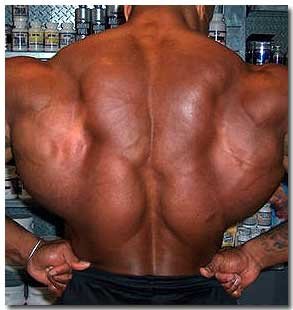 Like pull ups, heavy rows are one of the best exercises to train your back. The king of rowing exercises is the standing barbell row, but the problem is that too few people perform them properly.
Like pull ups, heavy rows are one of the best exercises to train your back. The king of rowing exercises is the standing barbell row, but the problem is that too few people perform them properly.
You might see the following common technique flaws in people executing barbell rows:
- momentum – using the posterior chain to generate momentum, instead of using the muscles of the back and arms
- rounded back – weakness in the lower back or hip tightness can cause your lower back to round, which is bad for the spine
- standing upright – you have to bend over nearly parallel to the floor in order to work the upper back properly
As I mentioned last week, you can fix all of these issues by switching from barbell rows to inverted rows, or you can learn how to perform barbell rows correctly.
Let’s talk about how we can best use barbell rows in our training routines.
Benefits of Barbell Rows
Bent over barbell rows might not be as hard as squats or deadlifts, but they certainly are harder than bench presses. Typically when your barbell row strength increases, you will see an increase in your other lifts. When you can barbell row with perfect form, as much weight as you can bench press, you know you have a balanced physique.
Here are some of the great benefits you’ll get when you incorporate barbell rows into your training:
- Back strength. First and foremost, barbells rows strengthen the muscles in your upper back – lats, traps, neck, rotator cuffs, and all those little muscles that you don’t really know about. Back strength is important for all those exercises you love, like squats, deadlifts, overhead press, Olympic lifts, and even the bench press.
- Better posture. A strong back will help you keep your shoulders in line with the middle of your body. Too much chest training and too little back training causes your shoulder to slouch, which leads to muscle imbalance and injury.
- Grip strength. When you train barbell rows without letting the weight hit the floor between reps, you keep constant tension on your forearms and it can help build your grip strength for those heavy deadlifts.
- Trunk stabilization. Barbell rows force you to use your abs, hips, glutes, lower back, and hamstrings to stabilize your body while you suspend the weight in front of you. This is a great way to teach posterior chain stability with heavy loads under constant tension.
How to Perform a Barbell Row
Pull a barbell from the floor up to the bottom of your rib cage, aka the xiphoid process, then let it back down. Simple.
- Bar Position. The bar should sit directly under your rib cage, over your feet, and close to your body.
- Stance. I got into the habit of using a wider deadlift stance when rowing, but I think it allowed me to use too much weight, which caused my rowing form to suffer. Nowadays I use a stance no wider than shoulder width, which helps me to keep my form much more strict. A wider stance might be used with Pendlay rows.
- Knees. Your knees should not be locked. You want to keep them slightly bent throughout the movement, but do not flex or extend them to generate momentum. They should not move at all for the duration of the exercise.
- Torso. Your torso should be parallel to the floor, or darned close to it. Far too many people stand upright when they row, and do you know what that’s called? An “Upright Row”, which is a totally different exercise. If you are not parallel to the floor, then you are most likely using too much weight, or you’re just plain lazy.
- Elbows. The elbows should be held at a 45 degree angle to your body. You don’t want them flush against your sides, nor flared out to the side. Try to make your shoulder blades touch and pull your elbows towards the ceiling.
- Chest and chin. You might see Arnold Schwarzenegger looking down when he barbell rows. I disagree with that, as you might end up rounding your lower back. You should always keep a straight back, chest puffed out, and chin up. However, that doesn’t mean to look up or even to look straight ahead, both of which could hurt your neck. You’ll want to look down at about 45 degrees.
- Grip. The conventional barbell row uses a pronated grip, like pull ups. A great variation is supinated barbell rows, like chin ups. I like them both. Your hands should be an inch or two wider than shoulder width apart, no more.
- Getting into position. Some people prefer to the lift the bar off a rack and bend over into position. Others prefer to deadlift the bar off the floor then bend over into position. Those who reset the bar on the floor after each rep don’t have to worry about it, as they are already in position when they bend down to grasp the bar.
- Reset between reps. Some people choose to reset the barbell on the floor between reps, but I don’t like that style. I think a set of barbell rows should be performed without a reset, keeping constant tension on the back, trunk, and posterior chain. If you choose to reset the bar between reps, that’s fine too. I don’t have a problem with it either way.
- Breathing. Take a big breath then pull the weight to your chest. Breathe out at the top or on the way back down. Take another breath before you start the next row. For those who use a reset, you can breathe on the floor between reps.
The video below claims to demonstrate a Pendlay Row (described in more detail below), but I see it as more of a really strict standard pronated bent over barbell row with a bottom reset. I prefer this technique without the reset personally, though most people I see perform the barbell row with a more upright position.
Technique Variations for the Barbell Row
- Pronated grip – more back.
- Supinated grip – more biceps.
- Neutral grip – like a T-bar row, requires a special bar or special equipment.
- Fat bar – more grip.
- Thin bar – less grip.
Pendlay Rows – Start in the same position as a regular barbell row, with your upper back flat. When you row, arch your upper back and look straight ahead. When you let the weight back down, you should relax your upper back so that it is flat again. You must touch the bar to the floor between reps to perform a Pendlay Row.
This is pretty similar to the standard row, but you are fully contracting the lats, which you won’t do if you keep your back flat throughout the movement. It is more of an advanced exercise. You must have full control over all of your muscles to perform this correctly.
Based on the research I did for this post, I’m going to be switching back to Pendlay Rows for a while. I want to remember how it feels to row the bar explosively from a full reset.
Common Barbell Row Mistakes
- Using hip, knee, or ankle extension for momentum.
- Flaring the elbows out to the sides.
- Pulling the bar too far away from your body.
- Bringing your chest to the bar. You want to bring the bar to your chest.
- Not keeping your torso parallel to the floor.
- Using too much weight. You gotta keep your form intact.
- Using too little weight. Come on push yourself. You should be able to row as much as you can bench!
- Women thinking they should avoid this exercise. Like all exercises, women should use barbell rows too.
Tags: back, back training, barbell rows, bent over rows, bodybuilding, exercise, fitness, lats, rowing, rows, strength training, traps, Weight Training, weightlifting











I stopped doing barbell rows after I had a very bad leg joint pain.
Read more at https://www.projectswole.com/weight-training/how-to-do-barbell-rows/#zA4zgU4AbY3Axb2b.99
This exercise is key to a strong upper back, therefore a big bench.
must try! 🙂
I can try this.
Row was much as I can bench? No way.
must try this.
I recommend the dumbbell version …. You have a much larger range of motion on the top. Much more success with it!
It is fessible to lose weight rapidly but you should be realistic and accept that if you lose weight quickly then you will invetibly put it all back on again just as quickly.I lost 6 pounds over the past few weeks.
Any way thank for sharing such a great and helpful information with us.
I stopped doing barbell rows after I had a very bad leg joint pain. Be careful and awlays do it with support to cut down minimal injuries.
so when doing the barbell row, i should reset by putting the barbell on the floor? i been doing it without setting it on the floor.
I’ve always done it without the reset. I think you should try both ways and use the one that works best for you. Then occasionally switch over to the other method to change it up.
Great post and video – thank you for sharing. I now will try to implement these in my gym routine.
how about the t bar row?
That’s next on my list.
The back is one of the crucial places to train because of it’s importance to the whole structure of the body, yet it is probably one of the most under trained parts of the body. You have hit the nail on the head with the emphasis being on technique. The back is also very prone to injury, and serious injury at that so using the correct technique for your Barbell Rows is crucial, especially if you are using heavy weights.